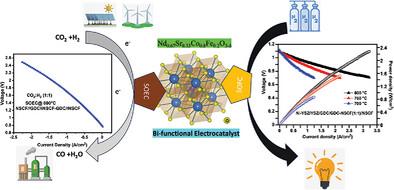"Bifunctional Strontium-Iron Doped Neodymium Cobaltite: A Promising Electrocatalyst for Intermediate Temperature Solid Oxide Fuel Cells and CO2 Electrolyzer"
IF 13
2区 材料科学
Q1 CHEMISTRY, MULTIDISCIPLINARY
引用次数: 0
Abstract
A novel intermediate temperature solid oxide fuel cell cathode, Nd₀.₆₇Sr₀.₃₃Co₀.₈Fe₀.₂O₃-δ (NSCF), synthesized via auto-combustion, exhibits exceptional mixed ionic-electronic conducting properties with a cubic perovskite structure. At 800 °C, NSCF demonstrates high electrical (1003 S cm−1) and ionic (1.676 × 10⁻2 S cm−1) conductivities, with activation energies of 0.0335 and 0.481 eV, respectively. Electronic analysis confirms its metallic nature, while the calculated oxygen migration energy (0.455 eV) correlates with experimental ionic conduction activation energy. The negative bulk oxygen vacancy formation energy (−38.70 kcal mol−1) indicates efficient oxygen reduction reaction and CO₂ electrolysis kinetics. Electrical conductivity relaxation shows non-debye behavior, with Dchem of 5 × 10⁻⁴ cm2 s−1 and Kex of 6.450 × 10⁻⁴ cm −1s at 800 °C. NSCF exhibits low interfacial polarization resistance (0.05 Ω cm2) and area-specific resistance (0.025 Ω cm2), further reducing to 0.014 Ω cm2 with an NSCF-GDC Gadolinium doped ceria interlayer. An anode-supported cell achieves peak power densities of 2.27, 1.52, and 0.86 W cm−2 at 800, 750, and 700 °C, respectively. In SOEC mode, NSCF demonstrates excellent CO₂ reduction capability of constant current density of −1.1 A cm−2 with stable 55-h performance, which establishes its potential both as IT-SOFC cathode and CO2 electrolysis catalysts.

求助全文
约1分钟内获得全文
求助全文
来源期刊

Small
工程技术-材料科学:综合
CiteScore
17.70
自引率
3.80%
发文量
1830
审稿时长
2.1 months
期刊介绍:
Small serves as an exceptional platform for both experimental and theoretical studies in fundamental and applied interdisciplinary research at the nano- and microscale. The journal offers a compelling mix of peer-reviewed Research Articles, Reviews, Perspectives, and Comments.
With a remarkable 2022 Journal Impact Factor of 13.3 (Journal Citation Reports from Clarivate Analytics, 2023), Small remains among the top multidisciplinary journals, covering a wide range of topics at the interface of materials science, chemistry, physics, engineering, medicine, and biology.
Small's readership includes biochemists, biologists, biomedical scientists, chemists, engineers, information technologists, materials scientists, physicists, and theoreticians alike.
 求助内容:
求助内容: 应助结果提醒方式:
应助结果提醒方式:


